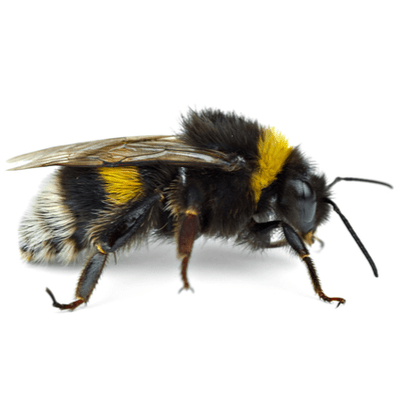
Color: Black with yellow (rarely orange) markings; with overall fuzzy appearance, including top surface of abdomen.
Size: Adult worker bumble bees measure in body length about 1/4-1" (6-25 mm), queens about 3/4-1" (17-25 mm) long.
Bumble bees don't make holes or tunnels in wood, but will nest in abandoned rodent burrows, under piles of grass clippings or leaves, stones, logs. Occasionally, bumble bees will establish a nest above ground in a wall, firewood pile, shed, crawl space or attic.
As social insects, bumble bees live in colonies. Each spring a queen that has survived over wintering will find a suitable nesting site and establish her colony. Her first brood of eggs matures into workers that forage on pollen and nectar for food. The workers do produce honey, but it is not edible to humans. The bumble bees colony grows larger over the summer and is usually discovered while gardening or mowing the lawn. The bumble bees will attack to defend their nest, so they are considered a health concern. Each worker forages independently, and bumble bees never exchange food. Old cocoons are used to store both pollen and nectar. Only enough food (honey and pollen) for a few days is stored at any given time which helps discourage nest predation by skunks, foxes etc.
Pollens and Nectar
Although bumble bees are normally harmless when foraging, a disturbed colony can be nasty. Guard bees stand ready to protect the nest against predators, including skunks and man. The bumble bees will attack to defend their nest, so they are considered a health concern.
A bumble bee nest should not be disturbed or destroyed because of its high pollination value. If a colony becomes life-threatening to humans, the bumble bees should be considered pests and eliminated.
- Remove flat items that could provide a nesting site for bees: boards, plywood, other loose building materials, tarps or other junk. (This will not only reduce the chances of bumble bees nesting too close to house, children or pets but will also make your garden look nicer).
- Flat rocks, stones or bricks should be removed unless they are part of a pathway or other decoration. Examine the ground beneath stones or brick for possible mouse holes which need to be filled in. Check these items to make sure that they are packed down to make good contact with the ground.
- When working in flower beds, gardens, etc. or when cleaning up other such areas around the home, be cautious when dealing with any flat board, stone, bricks, etc. as these are the most likely sites for a nest.
- Clean up yard of unwanted mulch or other such organic debris.
- If you find a nest, it is best to leave it alone and let the drones and workers die off during the winter. Use this option only when you are positive that children, pets or workers in the area are not at risk of being stung by the bees.
Manufacturer Recommended Products And Treatment For Bumble bee Control
Pests need food, water, and shelter. Often the problem may be solved just by removing these key items. Before even thinking about chemical pest control, it is important to be aware of
| Conducive Condition | Recommendation | |
| 1 | Tree branches on house | Keep tree branches away from house to reduce pest access |
| 2 | Firewood next to foundation | Keep firewood away from house to reduce pest harborage |
| 3 | Debris on crawlspace/next to foundation | Remove wood debris to reduce termite ha rborage area |
| 4 | Excessive plant cover, stump, etc. | Providing spacing between plant cover and structure |
| 5 | Soil above the foundation Ii ne | Keep soil below top of foundation to reduce harbo rage areas |
| 6 | Wood-to-ground contact | Keep soil from touching wood to eliminate termite access |
| 7 | Debris on roof/full gutter | Keep gutter & roof free of debris to reduce insect harborage |
| 8 | Standi ng water near/under structure | Eli minate standing water to reduce pest harbo rage |
| 9 | Mo isture problem under structure | Increase ventilation to reduce pest harbo rage area |
| 10 | Openi ngs at plumbi ng & electronics | Seal opening to reduce pest access |
| 11 | Excessive gaps at windows/doors | Seal gaps to reduce pest access |
| 12 | Lea ky plumb ing fixtures | Repair to reduce moisture for pests |
| 13 | Keep garbage cans covered | Covered to reduce attraction of insects of vertebrate pests |
| 14 | Mo isture damage wood | Repair rotten or damaged wood to reduce insect harborage |
| 15 | Grocery bags stored improperly | Seal paper sacks in containers to reduce i nsect ha rborage areas |
| 16 | Pet food unsealed or left out | Keep pet food in sealed containers and unavailable to pests |
| 17 | Excessive storage conditions | Keep storage areas uncluttered and manageable |
| 18 | Debris below kick plates | Remove kick plates to reduce rodent harborage |
3 products




